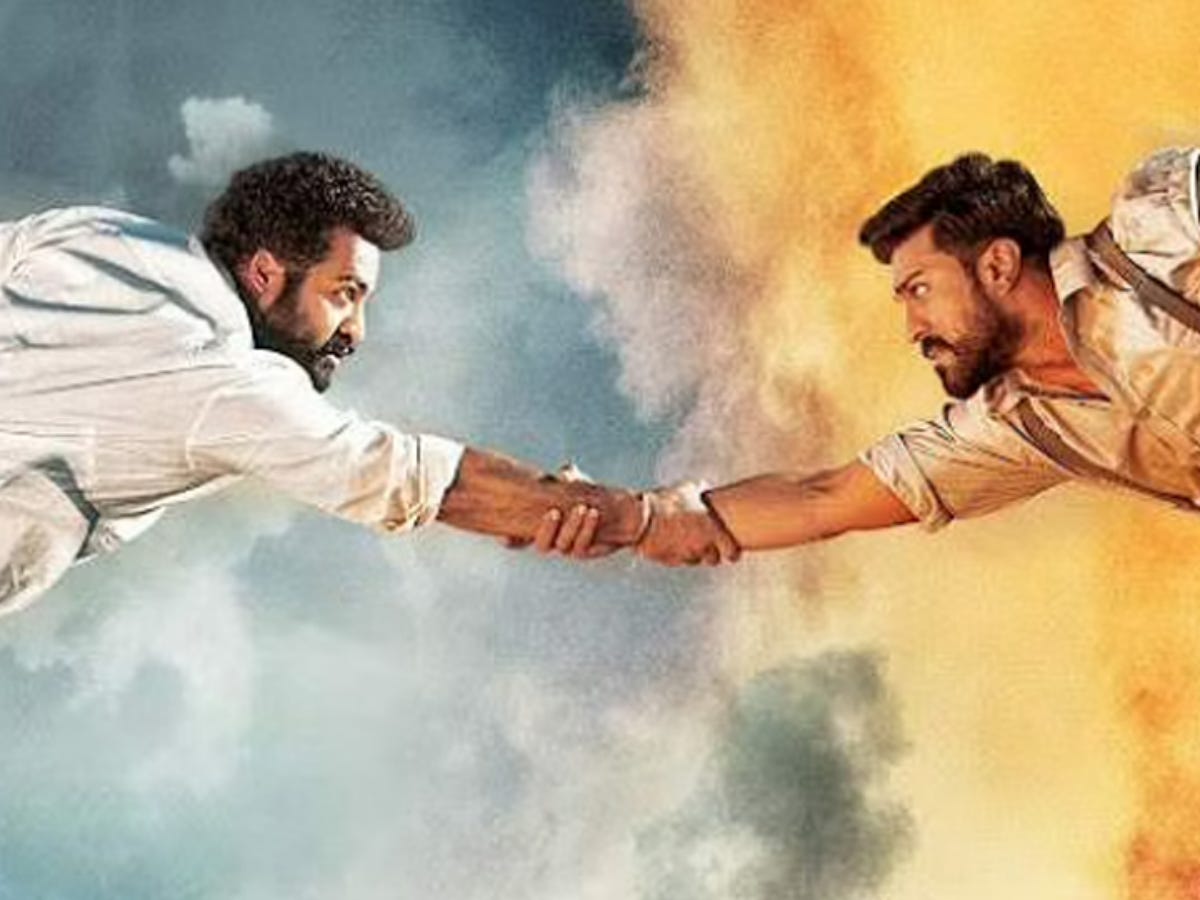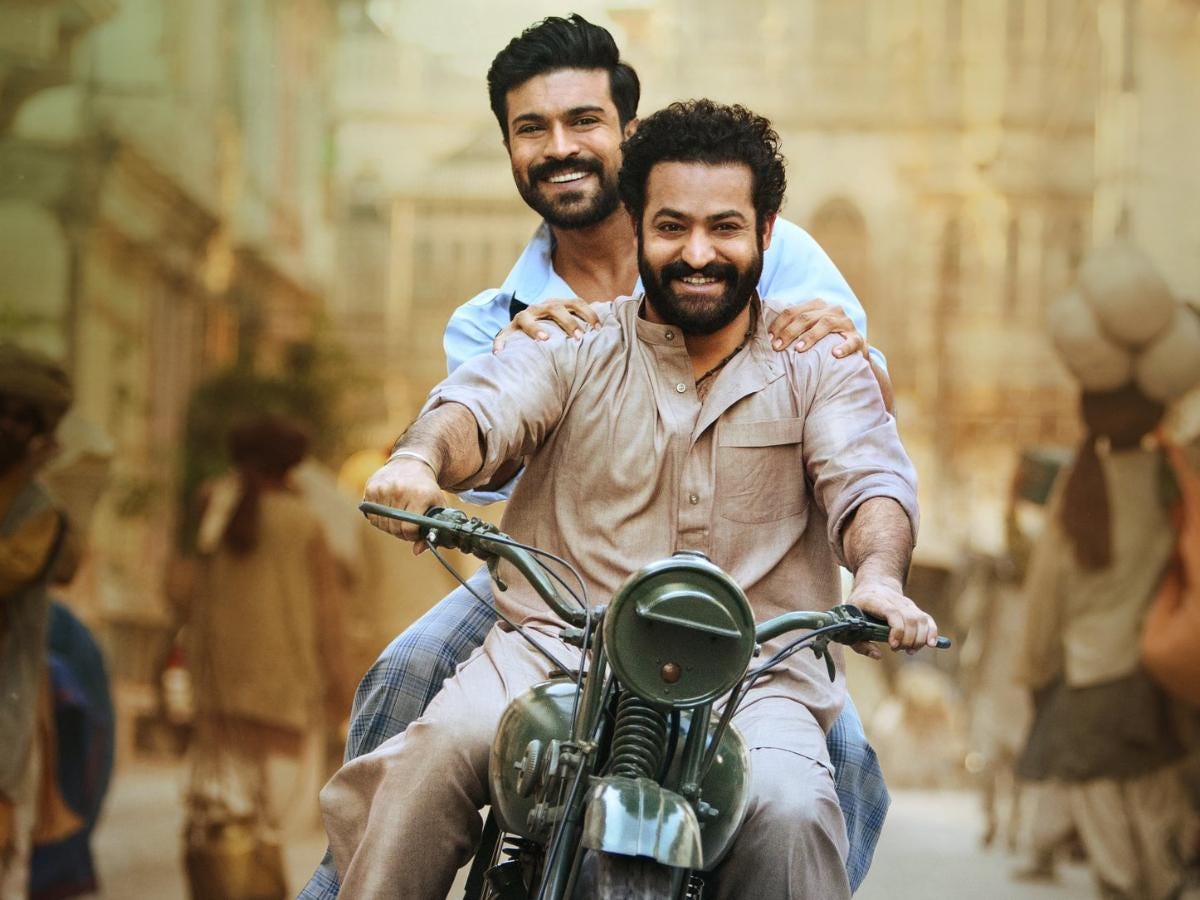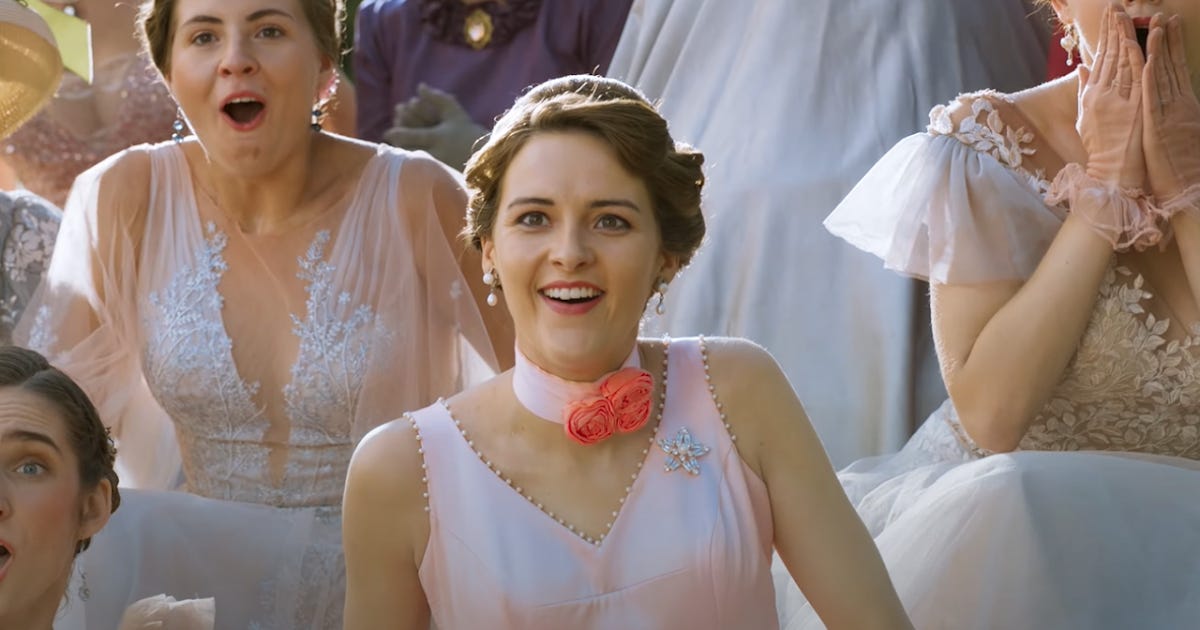Bolly High
The Indian action epic "RRR" is conquering US audiences, and for good reason: It's astonishing. And not without its issues.

The Nut Graf: Coming to you straight outta India, “RRR” (available on Netflix, ***1/2 stars out of ****) may be the most exhilarating three hours you’ll spend staring googly-eyed at a screen this year.

The stealth assault on the American consciousness by the Indian action extravaganza “RRR” has been fun to watch over the past few months. A lot of my fellow movie critics lost their minds when the film debuted in selected markets in late March, and the drumbeats grew loud enough for its recent arrival on Netflix to be accompanied by a theatrical re-release and even more exploding heads. Last time I checked, “RRR” was comfortably situated in the streaming service’s Top 10, and for good reason: It’s an insanely entertaining three hours, with one foot in epic Hindu myth, one foot in delirious Bollywood-style excess, and one foot in high-octane digitized action choreography. I know, that’s three feet. But it’s that kind of movie. (And I haven’t even mentioned the intentionally vague, possibly dicey politics. But we’ll get there.)
The title, we learn about 20 minutes in, stands for “Rise. Roar. Revolt.” If you’re a devotee of Indian film, it also stands for “Rajamouli/Ram Charan/Rama Rao” after director S.S. Rajamouli and the film’s stars, the last two an unusual and exciting pairing in a cinema generally predicated on lone heroes. Taking place in 1920s India, “RRR” pits two almost superhuman figures against each other and against the British colonial Raj. Bheem, played by the burly N.T. Rama Rao Jr., is a leader from the rural Gond tribe arriving in Delhi to rescue a young girl who has been bought by the cruel wife (Alison Doody) of the even crueler British Governor (Ray Stevenson), for reasons having to do with henna maintenance (I think). Raju Ram, a ramrod officer with the colonial police force, vows to capture Bheem and earn a rare promotion for a local in service to the Raj; Ram is played with sleek, lethal charisma by Ram Charan. It’s a buddy film that could in all fairness be titled “Enemies: A Love Story.”

How tough are these two? We first see Ram wading into a violent crowd a thousand strong to bring back one miscreant; he basically beats up a mob. Bheem, meanwhile, is back in the jungle wrestling tigers into submission. They meet cute while rescuing a little boy from a flaming river under a bridge that’s collapsing from a train crash, swinging by ropes from each side to shake hands in the middle. As one does. “RRR” is pitched at the level of a modern myth, and, indeed the film’s characters and subplots consciously borrow from India’s two core legends, the Ramayana and the Mahabharata. Anyone expecting psychological complexity or nuanced dialogue is in the wrong building, the wrong country, the wrong planet: This is the national epic as a glorious cinematic comic book, with dashing cutout-doll heroes, moustache-twirling villains, melodramatic U-turns, and an eyelash-batting bromance that carries more genuine eroticism than any of the actual male-female romances, Ram with his far-off love Sita (Alia Bhatt) and Bheem with the Governor’s liberal-minded cousin (Olivia Morris). (I wouldn’t be at all surprised if the movie launched a thousand doctoral dissertations on queer subtexts in Indian cinema, all of which would be strenuously denied by the filmmakers.)
Caveat for sensitive stateside viewers: “RRR” isn’t often violent, but when it is, it’s more brutal than the average American audience might be used to. The violence hurts, which is good, but it’s also over-indulged at times, especially when one of the heroes gets whipped in a scene that would almost certainly earn the Mel Gibson Seal of Approval. Against that, you have an absolutely irresistible musical number, “Naatu Naatu,” in which Ram and Bheem – who still don’t know each other’s true identities – engage in a high-energy dance-off with the snippy Brits that leaves everyone gasping for breath, the audience included.
The energy and broad-strokes excitement of “RRR,” the sheer craft that has gone into its excess, make it the kind of addictive live-action cartoon Hollywood strives so hard to manufacture and so often fails at. An exception, of course, is this summer’s “Top Gun: Maverick,” which I have gone off about in an earlier post while acknowledging it as pretty much the Platonic Ideal of the modern summer blockbuster. And just as that film buries its politics, conscious or otherwise, far beneath its escapism, so, too, does “RRR” reflect a fuzzily articulated agenda rooted in actual events and historic figures. Both the movie’s heroes are based on Indian revolutionaries of the 1920s: Alluri Sitarama Raju, a guerilla fighter who did in fact dress up like the mythological Rama, as Ram does in the final scenes, and Komaram Bheem, a revolutionary from the Gond tribe in Hyderabad. The two never met in real life, and “RRR” bends itself into an unoffending pretzel with an opening credit stating that “the producer, director, or the technicians of the movie have no intention whatsoever of hurting anyone’s sentiments or disrespecting any traditions or maligning the beliefs of any individual or group.” Which I guess makes sense in a domestic film market serving 28 states, several belief systems, and 447 languages. (That’s not a typo.)

In fact, it’s a mistake to think of “RRR” as a Bollywood movie at all. In India, there’s “Bollywood” – the Mumbai-based, Hindi-language film industry that dominates the country’s pop culture and represents it to the world – and then there are the production centers of other states, lumped under the misleading catchall “regional cinema.” There’s “Mollywood” (Malayalam-speaking, based in Kerala), “Jollywood” (Assam), “Chhollywood” (Chhattisgarh, in central India), and, my favorite neologism, “Sandalwood” (Kannada-language films from Bangalore). S.S. Rajamouli is a leading figure in “Tollywood,” the Telugu-language film industry of the country’s southeast, and his earlier films (many available on Netflix, Amazon, and elsewhere) have been key factors in turning India’s “regional cinema” into country-wide box office draws. With “RRR,” he has gone global, although not without cultural dilution: the movie was filmed in Telugu but has been dubbed into Hindi for US release, and that’s the version playing on Netflix.
How dodgy are the film’s politics? As a rank outsider, I can’t weigh in, but I will note that “RRR” ends with a lavish musical paean to historic and current “freedom fighters” from many of the country’s regions that turns the film into a rousing propaganda poster. Propaganda for whom? Though the filmmakers and the film’s fans might deny it, a number of critics see strong echoes of the right-wing Hindu nationalism of Prime Minister Narendra Modi, with writer Ritesh Babu providing an especially in-depth and impassioned dive into the political, historic, cultural, and cinematic contexts surrounding the film. (A just-published piece in Slate by Nitesh Pahwa also parses the subtexts of “RRR,” particularly its erasure of Muslim independence figures and the troubling ways in which tribal warrior Bheem subjugates himself to the more god-like Ram in the final scenes.) It’s been noted by more than one observer that Mahatma Gandhi is conspicuously missing from that final roll call, consistent with his downgrading by the Hindutva right and elevation of his nationalist assassin. And certainly audiences on the far right in America stand to take to heart any movie that devotes a scene to the necessity of guns — lots of guns — as both a tool of government overthrow and a source of general manliness.
Does that detract from the delightful maximum sensory overload of “RRR”? Not if you’re able to keep several conflicting ideas in your head at once and maybe think (and read) about them afterwards. For myself, I’ll only say that the movie is one of the most outrageously absorbing entertainments of 2022 – and that nothing in pop culture is free from politics. Especially the pop culture that insists it is.
If you enjoyed this edition of Ty Burr’s Watch List, please feel free to share it with friends.
If you’re not a paying subscriber and would like to sign up for additional postings and to join the discussions, here’s how:
If you’re already a paying subscriber, I thank you for your generous support.




